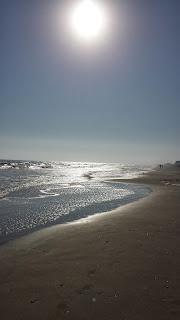November Beach Trip
There’s nothing more relaxing than a stroll down the beach on a beautiful day and it’s especially nice during the fall when tourism is low. Much quieter. Sometimes I will be the only person
there on the surf giving me the sensation that I’m the last soul on this
earth. As if the beach is all mine, to
do with whatever I please. I stroll for
miles it seems without a care in the world.
Just me, the salty air, the crashing waves, and the wildlife it
possesses. In Richard Bode’s book “Beachcombing at Miramar”
he says “Why do people all over the world flock to the sandy shore? I think
it’s because the instant they touch the sand, the moment they hear the surf,
the evil spirits flee and they feel at home in the world.” Each and every time I come here I
can hardly contain the excitement of not knowing what I will come across on
these sandy shores. What gifts will the
sea present to me?
I found this balloon that had washed up, which I collected and disposed of. These along with plastic bags when floating on the surface of the ocean can be mistaken for jellyfish by sea turtles consuming them by mistake. Dead sea turtles have been discovered with these in their stomachs.
Redfish (aka red drum) carcass. Looks like a fisherman caught this, filleted it, then left the rest for the shorebirds.

The first thing I notice as I cross
over the dunes is the magnitude of railroad vines that have taken up residence
there. These vines (aka- bayhops, beach
morning glory, goat’s foot creeper, goat’s foot morning glory)- are a trailing
species of plant that have a deep root system.
They have been planted here in order to help reestablish and “anchor”
the dunes (which help prevent beach erosion) in place making it less likely for
them to wash away during a storm surge as happened following the landfall of
Hurricane Ike in September 2008. Its
leaves and branches contain alkaloid compounds which protect it from being
eaten by insects and grazing mammals.
I found this balloon that had washed up, which I collected and disposed of. These along with plastic bags when floating on the surface of the ocean can be mistaken for jellyfish by sea turtles consuming them by mistake. Dead sea turtles have been discovered with these in their stomachs.
Collected sea
glass. Each time I come across a shard
of sea glass I marvel at the effort that the waves and the sand have put forth
in order to create, what was once trash, into a work of art. To not take it as a gift from the sea would
be sacrilege…..
Collected plastic that will go in the recycling bin. (More on plastics and the environment in a future post.)Redfish (aka red drum) carcass. Looks like a fisherman caught this, filleted it, then left the rest for the shorebirds.
Nearby I discover a
trail of sanderling tracks. This tiny
sandpiper is known by many other names- surf snipe, beach-bird, white snipe,
beach plover, whitey, bull peep. They
are long-distance migrants and nest only in the High Artic tundra.
During the winter
though they go to places like our beaches and stay until it’s time to head back
up north to nest. It is an opportunistic feeder meaning that it will pretty
much eat anything that comes along. They
are often seen probing the sand with their stout little bill for small
crustaceans, marine worms, amphipods, bivalves, and insects. Most times though you will see them in the
surf.
They will run quickly
to evade the oncoming waves, but then turn and pursue the wave as it recedes,
hoping the wave’s motions will stir up small mollusks or crustaceans.
They will even take
advantage of carrion, as I witnessed one nibbling on the remains of a
redfish. Another interesting fact- it
has an anatomical feature that it not found in any other sandpiper- it has no
hind toe. Ever so often I hear their
sharp “chit” call as they scurry along the shoreline.
Fossilized Turtle Shell. I have found quite a bit of these also in my years of beachcombing.
A collection of
whelk shell fragments- In all my years
of beachcombing here on Bolivar
Peninsula Texas
Gull tracks. Not far from these tracks were a herring gull
and a smaller ring-billed gull. Herring
gulls will take mussels which are hard to open and drop them on the wing onto
rocks to try and break them.
References and Suggested Reading:
1) Beachcombing at Miramar .
Richard Bode. © 1996 (If
you ever want to read an enlightening book about a guy who beachcombs along the
beach of Miramar in California, who gives life lessons in the process, do
yourself a big favor and buy this book.)
Labels: beach, beachcombing, bolivar peninsula, herring gull, kemp's ridley sea turtle, loggerhead sea turtle, railroad vines, redfish, Richard Bode, ring-billed gull, sanderling, sandpiper, sea glass, turtle shell, whelk












.JPG)





